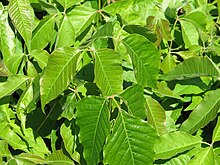Poison ivy
| Poison ivy | |
|---|---|
 |
|
| Poison ivy during autumn | |
 |
|
| Poison ivy in spring, Ottawa, Ontario | |
| Scientific classification | |
| Kingdom: | Plantae |
| (unranked): | Angiosperms |
| (unranked): | Eudicots |
| (unranked): | Rosids |
| Order: | Sapindales |
| Family: | Anacardiaceae |
| Genus: | Toxicodendron |
| Species: | T. radicans |
| Binomial name | |
|
Toxicodendron radicans (L.) Kuntze |
|
| Synonyms | |
|
|
Toxicodendron radicans, commonly known as eastern poison ivy or poison ivy, is a poisonous Asian and North American flowering plant that is well known for causing an itching, irritating, allergic and sometimes painful rash in most people who touch it, caused by urushiol, a clear liquid compound in the plant's sap. The species is variable in its appearance and habit, and despite its common name it is not a true ivy (Hedera), but rather a member of the cashew and almond family. Toxicodendron radicans is commonly eaten by many animals, and the seeds are consumed by birds, but poison ivy is most often thought of as an unwelcome weed.
There are numerous subspecies and/or varieties of T. radicans, which can be found growing in any of the following forms; all of which have woody stems:
The deciduous leaves of T. radicans are trifoliate with three almond-shaped leaflets. Leaf color ranges from light green (usually the younger leaves) to dark green (mature leaves), turning bright red in fall; though other sources say leaves are reddish when expanding, turn green through maturity, then back to red, orange, or yellow in the fall. The leaflets of mature leaves are somewhat shiny. The leaflets are 3–12 cm (1.2–4.7 in) long, rarely up to 30 cm (12 in). Each leaflet has a few or no teeth along its edge, and the leaf surface is smooth. Leaflet clusters are alternate on the vine, and the plant has no thorns. Vines growing on the trunk of a tree become firmly attached through numerous aerial rootlets. The vines develop adventitious roots, or the plant can spread from rhizomes or root crowns. The milky sap of poison ivy darkens after exposure to the air.
...
Wikipedia
